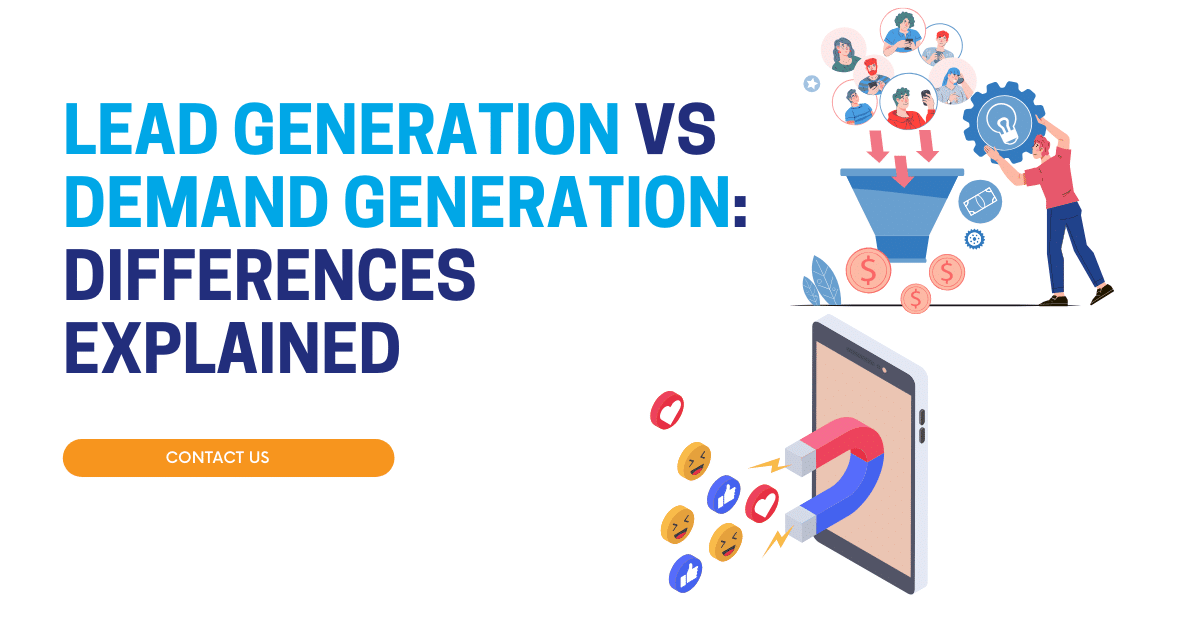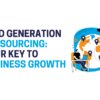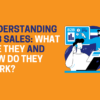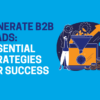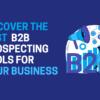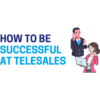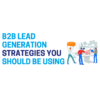Lead Generation vs Demand Generation: Differences Explained
There are a lot of B2B marketing terms out there, and when you’re trying to improve your business, you’re just hit with a wave of all of the terminology, and then you end up wondering what’s what and what the difference between all of these too. Specifically, what’s so different between “demand generation” and “lead generation”? If you look around long enough online, you’re going to see that they’re often used interchangeably.
However, they represent distinct strategies that play massive roles in attracting and converting prospects. It’s best to understand the differences between these two approaches. But why? The difference is much bigger than you might expect, and these two approaches can significantly impact your marketing success. So, we will drive into everything you need to know between demand generation and lead generation, helping you harness their potential effectively!
Understanding B2B Leads
Understanding the nature of B2B leads is fundamental to executing effective marketing strategies- but that’s pretty obvious, right? B2B leads are potential business clients already interested in your products or services. However, these leads differ from B2C leads as they involve more complicated decision-making processes and aren’t individual consumers either.
But what makes these leads so important compared to B2C? Well, it’s all about cultivation and how to properly identify them; both will significantly enhance your marketing and sales efforts.
What are B2B Leads?
Simply put it, B2B leads refer to businesses that have shown interest in a company’s products or services. These leads are pretty important for companies since it’s all about expanding your client base and increasing sales. A lead in the B2B context could be a company (or even an individual) within that company who’s shown interest through actions like downloading a whitepaper, filling out a contact form, or engaging with your content on social media. These are just a few examples, but there are plenty of other ways to get leads too.
Important of Quality B2B Leads
You have to keep in mind that not all leads are created equally, and this is where a lot of businesses get it all wrong. The goal is to convert leads into customers, and low-quality leads just won’t get the job done. Plus, high-quality leads are more likely to convert into paying customers.
How can you figure out what a quality lead is? Well, the best way to distinguish a quality lead would be by the level of engagement and how great the fit is for your ideal character profile. For example, a quality lead might be a decision-maker at a company that matches your target industry and has expressed a need for your solutions.
How to Generate B2B Leads
Generating B2B leads requires a strategic approach that combines various aspects and marketing techniques. After all, the whole goal is to attract and engage with potential clients, so there’s a bit of an art to it. Having an effective lead generation isn’t just about reaching out to as many prospects as possible- this is far from it! It’s about reaching out to as many prospects as possible but about implementing targeted strategies that resonate with your ideal customers.
Again, there’s a lot of work and a strategic approach involved, such as leveraging technology, creating valuable content, and continuously optimising your efforts to improve your results. It’s essentially a never-ending project because there’s always room for improvement in getting strong, high-quality leads.
Effective Lead Generation Strategies
Fortunately, there are plenty of strategies out there for generating B2B leads! So, if there’s something you (or your team) hate doing or lacks any effect, then there are options you can try instead. For example, there’s content marketing, email campaigns, social media outreach, and even SEO. Each method has its strengths and should be tailored to your specific audience.
For example, content marketing involves creating informative, valuable, and even entertaining content that addresses the pain points of your target audience, thus attracting potential leads. Email campaigns, on the other hand, can nurture these leads by delivering personalized content that guides them through the buyer’s journey.
Utilising Technology for Lead Generation
Just like any other marketing effort, you’re going to want to do whatever you can to streamline the whole process. So leveraging CRM systems is going to be your best bet in ensuring more efficient and targeted efforts.
Ideally, you’re going to want to look into tools like HubSpot, Salesforce, and Marketo, as they offer features such as lead scoring, automated email workflows, and detailed analytics that help in tracking and optimising lead generation activities. For example, automated workflows can send timely follow-up emails based on user behaviour, enhancing engagement and conversion rates.
Ideas for B2B Lead Generation
You have to keep in mind that you’re competing with so many other businesses, and it’s going to be innovation and diverse lead-generation tactics that keep your pipeline filled with high-quality prospects. So this is exactly why you’ll want to explore various methods and continuously test new ideas, as these can help you stay ahead in a competitive market. There’s a mix of strategies you could implement that you can count on to drive consistent lead generation.
Content Marketing
This was already mentioned before, but it’s so effective that it deserves some more attention! Creating valuable content such as blogs, whitepapers, and case studies can attract potential leads just by addressing their pain points and providing solutions. One great example that’s commonly used would be blog posts, and you could create a post that discusses common industry challenges and offers actionable insights that can draw in readers who are seeking solutions, positioning your brand as a helpful resource.
But there’s still so much content that you could try, too, such as offering downloadable content like eBooks or whitepapers in exchange for contact information, which can help build your lead database.
Webinar and Virtual Events
People love free events, especially when they provide value to them, and what better way than webinars and virtual events (which means you spend next to no money on these)? Hosting informative webinars and virtual events can engage your target audience, establish your brand as an industry authority, and generate leads through registrations. It usually helps to go with webinars, as these allow for real-time interaction with prospects, enabling you to answer their questions and showcase your expertise.
Plus, it’s easier to gain trust and to see you (and your team) as just people rather than a company. But obviously, when it comes to webinars or other virtual events, you need to get the word out, or you’re going to have zero prospects.
So, to maximise lead generation, be sure to promote your webinars well through various channels and follow up with attendees post-event with additional resources or personalised offers. The personalised approach helps, so don’t even bother with using templates—it needs to be human-to-human interaction!
Increasing B2B Leads for Marketing Agencies
There are a lot of marketing agencies out there, plus there are a lot of marketing experts out there working alone, so you have a lot of competition, meaning that you’re going to have a specially challenging time trying to generate high-quality leads. But it’s all about tailoring strategies, and your marketing agency will need to tailor its strategy to meet the unique needs of the clients so you can leverage partnerships- this way, you can effectively attract and convert leads.
Tailored Marketing Campaigns
So, just like what was mentioned above, it’s all about going for a more tailored approach, so your campaigns needs to be more customised so they can resonate with their clients specific needs and industry trends to attract high quality leads.
By conducting thorough market research and understanding the unique challenges of each client, agencies just like yours can create targeted messages and offers that appeal to the right audience. For example, a campaign tailored for a tech company might focus on innovative solutions and cutting-edge technology trends.
Partnering with Industry Influencers
You can never go wrong with collaborations, so why not collaborate with influencers in your niche? This can extend your reach and credibility, which means you can draw more leads through trusted recommendations. But of course, you shouldn’t pick just any influencer either; you need to pick one that has an established relationship with its audience and can effectively promote your services or products through reviews, testimonials, or even co-hosted events.
Generating B2B Sales Leads: Best Practices
This effectively requires adherence to best practices that ensure consistency and quality in your lead generation efforts. It’s all about focusing on nurturing relationships, utilizing social proof, and maintaining a strategic approach.
Nurturing Leads with Email Marketing
It’s all through personalised content and follow-up leads, and then gradually guiding them towards a purchase decision. But this could also include segmenting your email list based on factors like industry, job role, or even past interactions.
Leveraging Social Proof
Social proof is all about demonstrating that others have had success and benefited from your products or service, so it helps in reducing perceived risk.
Never Buy a Leads List
Buying leads lists might seem like a quick way to build your prospect base, but it can harm your business in the long run. Purchased leads often lack quality and relevance, leading to low engagement rates and high unsubscribe rates. Plus, there’s the potential of this damaging your business’s reputation, too, and don’t forget about the regulatory bodies like GDPR either. You’re better off going with ethical practices.
Finding and Improving B2B Website Leads
You need to keep in mind that your website is the first point of contact with potential leads, so it’s a critical component of your lead generation.
Optimising Your Website Lead Generation
You’ll want to make sure your website is designed to capture leads effectively, such as clear CTAs, landing pages, and user-friendly navigation. You should also keep in mind that effective lead-generation websites feature prominent contact forms, compelling CTAs, and landing pages optimised for conversions. For example, a landing page offering a free demo should have a straightforward form, persuasive copy, and minimal distractions to encourage sign-ups.
Implementing Live Chat Features
If your website doesn’t have this, then you’re definitely missing out because this can increase the chances of converting them into leads by addressing queries in real time. It’s about engaging and helping hesitant prospects.
What Do Most B2B Leads Come From?
Understanding the primary sources of B2B leads helps in optimising your marketing strategies and focusing your efforts on the most productive channels.
Primary Sources of B2B Leads
So, what are the mean sources? Well, they’re usually through organic search, paid advertising, social media, and even referrals. It helps to have an understanding that can help refine your strategies because one strategy might not work, and then there are others you could always try.
Analysing Lead Sources for Better ROI
If you’re regularly analysing your lead sources, this is going to provide the best insights on which channels are most effective, meaning you’ll know where to allocate resources to more. Tools like Google Analytics and HubSpot are perfect examples for tracking the performance of your lead-generation efforts.
Effecting Ways to Generate More B2B Leads
Generating more B2B leads involves adopting a proactive and multifaceted approach. It’s all about investing in proven strategies such as SEO, content marketing, and leveraging professional networks. It’s so important to stay updated with industry trends and continuously adapt your tactics to maintain a robust lead generation pipeline. But what else?
Investing in SEO and Content Marketing
SEO has been mentioned multiple times throughout this post, and it’s because of its sheer importance and impact. High-quality content can drive organic traffic, which can generate a steady stream of leads. Your content marketing can’t be generic; it actually needs to be insightful, or else it’s not going to work.
Utilising LinkedIn for Lead Generation
LinkedIn has proved to be a powerful platform for B2B lead generation, thanks to its opportunities to connect with decision-makers and show off your expertise. You can use LinkedIn’s advance search features to find and reach out to potential leads.
Conclusion
Understanding the nuances between demand generation and lead generation is crucial for any B2B marketer; while demand generation focuses on creating awareness and interest in your brand, lead generation aims to capture and convert that interest into actionable leads. Ideally, you should embrace both of these approaches, continuously refine your tactics, and make your lead quality and conversation rates soar.
To find out more about our B2B telemarketing lead generation, and appointment setting services, contact us today at 0330 808 0866 or email us at enquiries@theleadgenerationcompany.co.uk

As a Senior Digital Marketing Executive at The Lead Generation Company, Seonaidh drives transformative marketing strategies with a focus on innovation and results. With a keen eye on emerging trends, he empowers businesses to achieve unparalleled B2B lead generation success.






